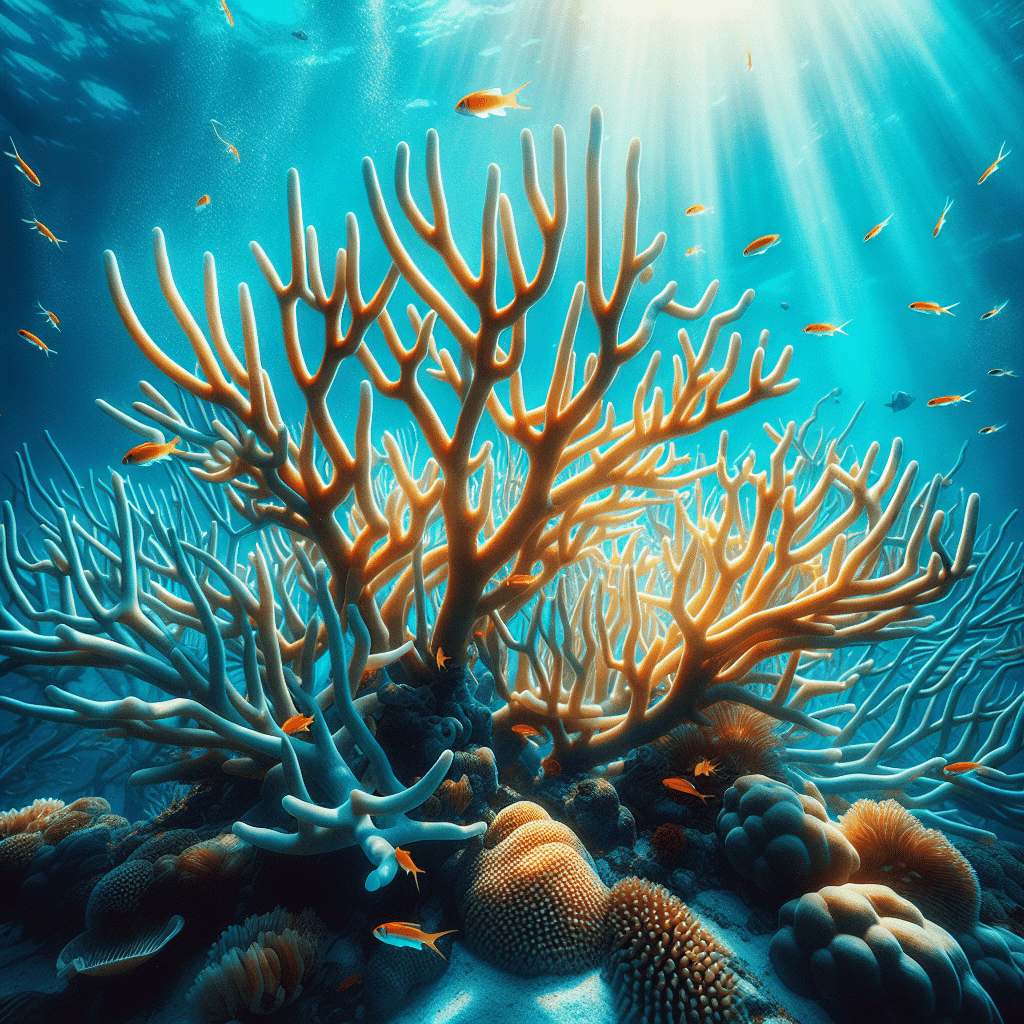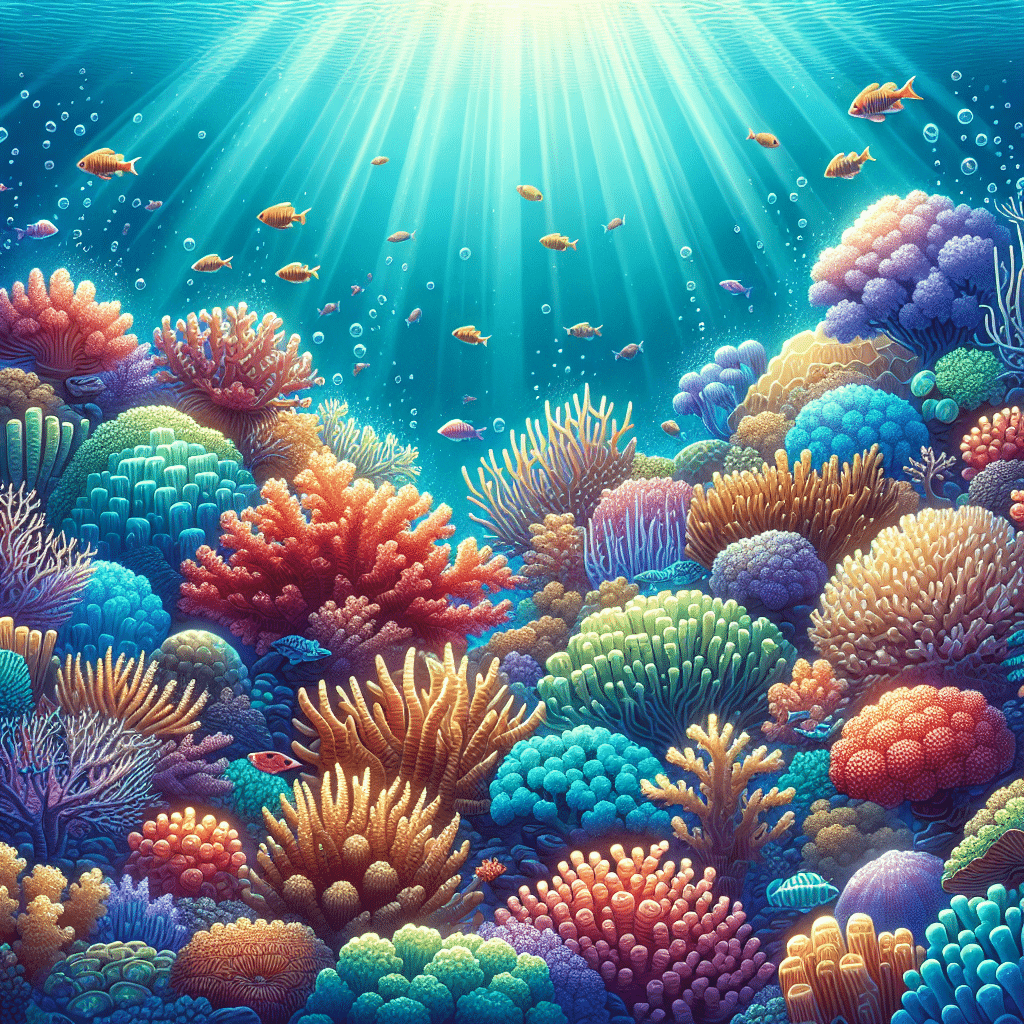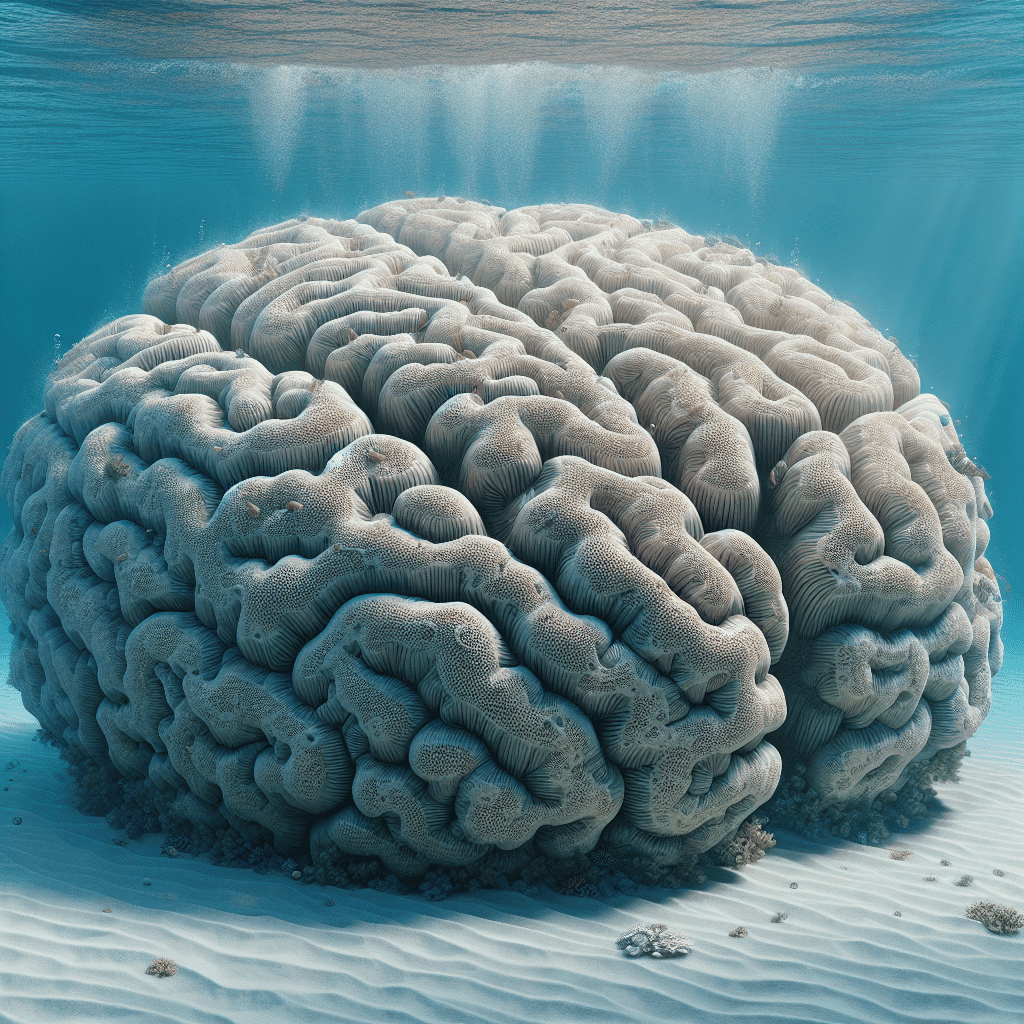Understanding Staghorn Coral
Fast Growth and Vulnerability
I’ve always been fascinated by staghorn coral. This vibrant coral species is known for its rapid growth, capable of reaching up to 8 inches per year. In fact, staghorn corals can add about 5 cm (or roughly 2 inches) of new skeleton for every 1 cm of existing skeleton each year, making them one of the fastest-growing coral species in the Western Atlantic (Wikipedia). This impressive growth rate allows them to play a crucial role in reef-building, providing habitat and shelter for juvenile fish and serving as a buffer against erosion and storms.
However, despite their fast growth, staghorn corals face significant threats. They were officially classified as a threatened species under the Endangered Species Act in 2006, and their population has dramatically declined—over 97 percent has disappeared due to factors such as white band disease (Green Matters).
Natural Habitat and Distribution
Staghorn corals thrive in shallow, warm waters typically found in the Caribbean and Western Atlantic. Their preferred habitats are coral reefs, which provide the necessary conditions for growth and reproduction. These corals contribute to the structure and stability of reef ecosystems, which are vital to marine biodiversity.
The colors of staghorn coral can vary widely, ranging from dark gray and brown to more vibrant shades of pink, purple, and blue. Unfortunately, the distribution of staghorn coral has significantly decreased over the years due to environmental changes and disease outbreaks. For those of us interested in reef tanks, understanding their natural habitat and distribution can help us create a more suitable environment for them in captivity.
If you’re looking to add corals to your tank, consider checking out other types like brain coral or mushroom coral for diversity in your reef ecosystem.
Threats to Staghorn Coral
Staghorn coral, like many coral species, faces a range of threats that can significantly impact its survival. As a fish tank and reef tank hobbyist, it’s crucial to understand these challenges to better care for and appreciate these beautiful organisms.
Climate Change Impact
Climate change is a major concern for staghorn coral. Higher water temperatures can cause the coral to expel its symbiotic algae, which are essential for energy production. This process, known as coral bleaching, not only affects the coral’s vitality but also turns them white, signaling stress (National Geographic). Additionally, ocean acidification contributes to the weakening of coral structures and impairs their ability to grow and reproduce effectively.
Here’s a quick summary of how climate change affects staghorn coral:
| Climate Change Effect | Impact on Staghorn Coral |
|---|---|
| Higher water temperatures | Coral bleaching and reduced energy |
| Ocean acidification | Weakens coral structures |
| Extreme weather events (e.g., hurricanes) | Physical damage to coral colonies |
Biological Threats
Staghorn coral is susceptible to various biological threats, including diseases and predation. One significant disease affecting these corals is white plague, which can lead to rapid tissue loss and mortality. Additionally, competition for space and resources from other organisms, such as algae and invasive species, can hinder staghorn coral growth and recovery.
| Biological Threat | Description |
|---|---|
| White plague | A disease causing tissue loss and mortality |
| Competition from algae | Can outcompete corals for space and resources |
| Invasive species | May disrupt local ecosystems and coral health |
Human-Induced Pressures
Human activities pose significant pressures on staghorn coral populations. Unsustainable fishing practices can damage coral habitats, while land-based sources of pollution contribute to water quality degradation. Sedimentation from coastal development can smother coral reefs, inhibiting their growth. Moreover, physical damage from anchors and boats can lead to further stress on these delicate ecosystems.
Here’s a breakdown of human-induced pressures:
| Human-Induced Pressure | Impact on Staghorn Coral |
|---|---|
| Pollution | Decreases water quality and stresses coral |
| Coastal development | Causes sedimentation and habitat destruction |
| Unsustainable fishing | Damages coral habitats and ecosystems |
Understanding these threats is crucial for maintaining healthy staghorn coral populations, whether in the wild or in my own reef tank. By being aware of these challenges, I can take steps to create a more supportive environment for corals and contribute to their conservation. For more information on different types of corals, check out articles on brain coral and black coral.
Conservation Efforts for Staghorn Coral
Staghorn coral is a vital part of marine ecosystems, and as a reef tank hobbyist, I’ve come to appreciate the importance of conservation efforts aimed at protecting these beautiful corals. There are several initiatives in place to restore and protect staghorn coral, and here’s a closer look at three key areas: coral restoration projects, protecting critical habitat, and sustainable practices.
Coral Restoration Projects
Coral restoration projects are incredibly important in the fight to save staghorn coral. Organizations like NOAA are actively working to grow and plant staghorn and elkhorn corals to restore damaged reefs. For example, one NOAA-supported project produced over 30,000 branching corals, which far exceeded their initial target of 12,000 coral colonies (NOAA Fisheries).
These projects often involve collecting and rehabilitating broken or threatened coral fragments, propagating coral colonies, and transplanting them back into their natural habitats. After Hurricanes Maria and Irma in 2017, NOAA reattached more than 10,000 broken corals as part of recovery efforts (NOAA Fisheries).
| Year | Coral Fragments Reattached |
|---|---|
| 2017 | 10,000+ |
| Target Goal | 12,000 |
Protecting Critical Habitat
Protecting critical habitats is another essential aspect of staghorn coral conservation. Healthy coral reefs provide shelter and food for various marine species, and preserving these habitats is crucial for the survival of staghorn coral. For instance, methods like using native sea urchins and sea-vacuuming have been pioneered in Hawaii to clear algal overgrowth that blocks sunlight and smothers corals (NOAA Fisheries).
Efforts to manage reef structures also play a role. Programs like the Florida Department of Environmental Protection’s Coral Reef Conservation Program work on restoration projects to repair direct impacts at vessel grounding locations.
Sustainable Practices
Sustainable practices are necessary for the long-term health of staghorn coral. These practices include reducing pollution, managing fishing activities, and promoting eco-friendly tourism. Educating reef tank hobbyists about the importance of using sustainably sourced corals and reef-safe products helps protect the natural populations.
As a hobbyist, I find it essential to support initiatives and products that contribute to the health of coral reefs. For example, understanding how to care for staghorn corals in my tank can help ensure that I’m not only enjoying their beauty but also participating in their conservation.
For more information on the types of corals and their care, check out articles on corals, acropora, and other reef species. These insights can help us all contribute to the preservation of these incredible marine ecosystems.
Importance of Staghorn Coral
Staghorn coral plays a crucial role in marine ecosystems, making it an important species for both environmental and economic reasons. As a fish tank and reef tank hobbyist, understanding the significance of this coral can enhance the appreciation and care for it in your aquariums.
Ecosystem Role
Staghorn coral is a vital component of coral reefs, which are often referred to as the “rainforests of the sea.” These reefs provide habitat and shelter for a diverse range of marine life. They support various species, including fish, invertebrates, and other corals, creating a complex ecosystem that sustains biodiversity.
Additionally, coral reefs, including those formed by staghorn coral, can reduce wave energy by as much as 97%. This property is essential for protecting coastal communities from natural disasters, such as tsunamis and storm surges (Blue Planet Aquarium). In this way, staghorn coral contributes not only to marine health but also to the safety of coastal regions.
Economic Value
The economic benefits of staghorn coral and coral reefs are significant. Globally, coral reefs contribute about $10 trillion a year to the economy, with domestic contributions exceeding $3 billion annually. This value stems primarily from tourism, fishing, and coastal projects that rely on healthy reef systems.
Moreover, coral reefs are crucial for the fishing industry, providing livelihoods for millions of people. They serve as breeding and feeding grounds for various fish species, which are essential for both commercial and artisanal fishing.
Coral reefs have also been instrumental in developing treatments for various medical conditions, including heart disease, arthritis, asthma, and cancer. Scientists have successfully used extracts from coral reefs to create these treatments, showcasing the importance of these ecosystems in modern medicine.
In summary, recognizing the importance of staghorn coral can deepen my understanding of reef ecosystems and the economic benefits they provide. This knowledge can enhance the way I care for and interact with these corals in my aquariums, ensuring their health and sustainability for future generations.
Characteristics of Staghorn Coral
Growth Rate and Size
I find staghorn coral fascinating, especially when I learn that they can grow up to two inches a year. This rapid growth rate makes them one of the fastest-growing coral species in the Western Atlantic. In fact, they can add about 5 cm (approximately 2 inches) of new skeleton for every 1 cm of existing skeleton annually, which is quite impressive.
Staghorn corals grow large, thick stems called “branches,” which can range from 1 to 3 inches in width. These branches grow closely together and often resemble the antlers of a stag, hence the name “staghorn.” A healthy colony can reach heights of at least 4 feet and diameters of 6 feet, forming dense thickets that provide crucial habitats for various marine species (NOAA Fisheries).
| Measurement | Size |
|---|---|
| Growth Rate | Up to 2 inches (5 cm) per year |
| Branch Width | 1 – 3 inches |
| Colony Height | Up to 4 feet |
| Colony Diameter | Up to 6 feet |
Reproduction and Spawning
Staghorn coral reproduces both sexually and asexually. During the spawning season, typically in late summer, they release eggs and sperm into the water column. This event usually occurs during a full moon, and it’s quite a sight to witness. The fertilized eggs develop into larvae, which settle on the ocean floor and begin forming new coral colonies.
In addition to sexual reproduction, staghorn corals can also reproduce asexually through budding. This process allows them to grow new branches from the parent colony, contributing to their overall size and resilience. Their ability to reproduce in multiple ways makes them a vital species for reef ecosystems, as they help maintain coral populations and contribute to reef-building efforts.
Understanding these characteristics of staghorn coral is essential for anyone involved in reef tank setups. Their fast growth and unique reproductive strategies can greatly influence the overall health and biodiversity of the aquarium environment. If you’re looking to incorporate staghorn coral into your tank, be sure to consider their specific care requirements and environmental needs. For more information on other coral types, check out our articles on brain coral, mushroom coral, and acropora.
Environmental Requirements for Staghorn Coral
Taking care of staghorn coral in my reef tank requires a good understanding of its environmental needs. These corals are quite sensitive and thrive under specific conditions. Here’s what I’ve learned about their water quality needs and the light and flow considerations essential for their health.
Water Quality Needs
Staghorn coral needs high-quality water to flourish. The ideal water parameters include:
| Parameter | Ideal Range |
|---|---|
| Temperature | 75°F to 82°F (24°C to 28°C) |
| pH | 8.1 to 8.4 |
| Salinity | 1.023 to 1.025 specific gravity |
| Ammonia | 0 ppm |
| Nitrite | 0 ppm |
| Nitrate | < 5 ppm |
| Phosphate | < 0.03 ppm |
Staghorn coral is sensitive to changes in these parameters, and fluctuations can stress or even harm them. Regular testing and adjustments help maintain a stable environment.
Light and Flow Considerations
Light is another critical factor for the growth of staghorn coral. These corals thrive in bright, indirect light. I aim for about 200 to 400 PAR (Photosynthetically Active Radiation) for healthy growth. I also pay attention to the type of lighting I use; LED lights work well because they can be adjusted easily.
Flow is equally important. Staghorn coral prefers moderate to strong water flow, which helps in nutrient exchange and keeps debris from settling on its branches. The ideal flow rate is about 10 to 30 times the tank volume per hour. This ensures that the coral receives enough nutrients while preventing the buildup of waste (NOAA Fisheries).
To sum it up, creating the right conditions for staghorn coral involves consistent monitoring of water quality and ensuring adequate lighting and flow. Fulfilling these needs helps my coral thrive and reach its full potential, growing up to eight inches per year under optimal conditions.
For more information on other types of corals, check out sections on brain coral or mushroom coral.
Challenges in Staghorn Coral Conservation
Conserving staghorn coral is not an easy task. I’ve learned that there are several challenges that need to be addressed, especially when it comes to genetic research and building resilience in these beautiful corals.
Genetic Research
Genetic research plays a crucial role in understanding and conserving staghorn corals. Staghorn corals are particularly vulnerable to environmental stressors like bleaching, and their low resistance to such stress makes them a priority for study (National Geographic). By researching their genetics, scientists can identify traits that may enhance their survival in changing conditions.
Understanding the genetic diversity of staghorn corals is essential. A diverse gene pool can help ensure that some individuals possess the resilience needed to withstand threats like ocean warming and acidification. This research can lead to more effective conservation strategies and restoration efforts. For example, researchers can selectively breed corals that show greater tolerance to heat or disease, increasing the chances for success in the wild.
Resilience Building Initiatives
Alongside genetic research, resilience building initiatives are vital for the conservation of staghorn coral. These initiatives involve raising staghorn corals in controlled environments, such as aquariums, to create a “bank” of these endangered species (New England Aquarium). By nurturing corals in a safe setting, scientists can study their growth and response to various stressors. This research helps identify strategies that could enhance their survival when reintroduced to their natural habitats.
Resilience initiatives also focus on educating hobbyists like me about sustainable practices that can minimize impacts on coral ecosystems. This includes promoting responsible aquarium keeping and reducing pollution that affects coral reefs. It’s important to understand how our actions can contribute to the overall health of coral populations.
In summary, tackling the challenges in staghorn coral conservation requires a multi-faceted approach. Genetic research and resilience building initiatives are vital components of successful conservation strategies. By learning more about these corals and supporting conservation efforts, I can play a part in helping them thrive in our oceans. For more insights on corals and their care, check out the corals section.
Staghorn Coral in Aquariums
Taking care of staghorn coral in an aquarium can be an exciting challenge. I find that understanding their needs and engaging in captive breeding programs can significantly contribute to their success in our tanks.
Captive Breeding Programs
Captive breeding programs for staghorn coral are vital for conservation efforts. These initiatives aim to create a “bank” of these endangered corals, ensuring their survival as we face various environmental threats. By raising staghorn corals in aquarium facilities, we can maintain healthy populations and potentially reintroduce them into the wild when conditions improve (New England Aquarium).
One of the fascinating aspects of these programs is the ongoing research into the genetics of staghorn corals. Understanding their genetic makeup can help identify traits that promote resilience in various environmental conditions. This research is essential for ensuring that the corals we introduce back into their natural habitats can thrive despite changing climates.
Research and Development
Research and development efforts surrounding staghorn corals are crucial for both conservation and aquarium hobbyists like me. These include studies exploring the best environmental conditions for growth, which are essential since staghorn corals are super sensitive to changes in water quality, light, and flow. Under optimal conditions, these corals can grow up to eight inches per year (New England Aquarium).
In addition to breeding programs, physical restoration methods are being explored to enhance coral habitats. Programs, such as those managed by the Florida Department of Environmental Protection, focus on repairing damaged reefs and increasing the available habitat for corals and other reef organisms. This not only benefits staghorn corals but also supports the diverse marine life that relies on these ecosystems.
For anyone looking to add staghorn coral to their reef tank, it’s essential to keep their specific needs in mind. Proper lighting, water quality, and flow are critical to their health and growth. By participating in and supporting captive breeding and research initiatives, I feel like I’m contributing to the broader efforts to save these beautiful corals and ensure they thrive both in our tanks and in the wild.



